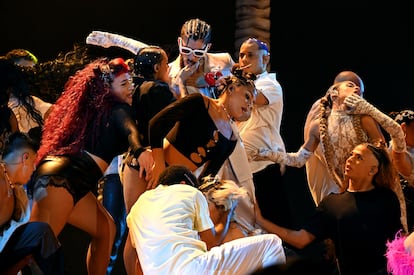Twerking against the patriarchy: Bad Bunny and the empire of pleasure
For the Mexican state, women who embrace their sexuality are not worthy of being mourned. It’s imperative to change this reality, so we can experience desire without fear of being killed
In my brief academic life, I have searched for signs of resistance in Latin American popular culture. If I can stumble across acts of popular resistance, I feel as if there’s some hope. Reggaeton, surprisingly – despite its commercialism – is a place where I’ve found some understanding. But before we get to Bad Bunny, let me share what came before the music.
While digging through the crime reports across my country, I started to hone in on a specific question. Why was it that the elderly victims of a serial killer – a woman popularly known as “La Mataviejitas” (the one who kills old ladies), splashed all over the newspapers and TV channels – mattered to the government, whereas the victims of femicide in Ciudad Juárez, Mexico City, or Tlaxcala have never been a priority?
In 2010, the American philosopher Judith Butler wrote a book titled Frames of War: When is Life Grievable? She observes that, for a life to be considered worthy of mourning by a society and a state, that life must first be recognized as life. And that recognition depends on how said life is framed.
Regarding the case of La Mataviejitas, it’s interesting to figure out why the murder of 49 elderly women shocked the Mexican nation, despite the long-standing context of an alarming number of femicides. For instance, the police search for the serial killer began in 2003… but in the 10 years before that, 382 women were recorded murdered in Ciudad Juárez. In those same years, in the state of Mexico, 4,379 untimely deaths of women were registered. But even with these thousands of registered murders – along with many more disappearances – the authorities and mainstream media outlets didn’t speak about a dehumanized, broken society. It was not until the grandmothers of Mexico were murdered that the authorities – including the attorney general – spoke of a dehumanized, decomposing society.
The murder of 49 elderly women unleashed a coordinated search for a serial killer. There were patrols at all hours – more than 800 officers were assigned to the case. The police in Mexico were not going to rest until they found the person responsible. None of this had ever previously happened when a woman was murdered. Oftentimes, mothers and friends of the murdered or disappeared girls and women are the only ones who search for them and their killers. Despite the thousands of victims of femicide, a national crisis has never been declared. In fact, there hasn’t even been a formal investigation, let alone a search party.

In 2002, Mariclaire Acosta – the Mexican government’s ambassador for human rights and democracy – was fired by President Vicente Fox “for not stopping Amnesty International’s publication of Intolerable Killings: 10 years of abductions and murder of women in Ciudad Juárez and Chihuahua.” Of course, dismissal is a mild fate compared to what has happened to others who have dared denounce unspeakable crimes. In Mexico – whether under Fox, or under the present administration of López Obrador – death is a common punishment for speaking about what no one seems to want to hear.
Why does the state mourn the murder of elderly women, but stay silent about the thousands of victims of femicide? Why are these lives not worthy of being publicly recognized, publicly mourned?
After years of research and marathon writing sessions, I finally finished writing a book in answer to these questions. After reading all the reports on femicide and comparing the news coverage of elderly victims of a serial killer to the daily victims of femicide, I came to a conclusion.
Who counts as a female victim in Mexico? Simply, women who represent the ideal woman and/or mother, established through ancient notions of Mexicanness – desexualized women, such as the Virgin of Guadalupe. Women who seem to have no sexual agency and who are the idealized guardian angels of their homes.
Now, who doesn’t count as a victim in Mexico? Which bodies aren’t considered worthy of mourning by the state? The ones that are sexualized. The bodies of women who transgress the normative roles assigned to them by conservative Mexican society. When young, poor, brown women are abducted, killed, or sold, their bodies are dismissed from the narrative.
It’s all about sexual agency: the ability to have the power and resources to develop and experience our sexuality.
Sexuality in the feminine body has always been viewed as so threatening and dangerous that it has to be annihilated. To annihilate is to murder – not to know, not to investigate, not to speak.
For almost a century, it was unknown where the female orgasm came from. Freud and many of his successors assumed that girls experienced clitoral orgasms, but grown women transferred the sexual response to the vagina. However, after much feminist research, it was concluded that women have a unified sexual organ, and that all parts react during arousal, regardless of which part is being stimulated. And women also experience female sexual dysfunction – much like how men experience erectile issues. This was never taken into account by medical authorities until very recently.

Despite all of this new understanding, across the world, unequal perceptions persist. Just as an example: in the 21st century, women’s nipples cannot be shown publicly under almost any circumstances – if you do so on almost any social network, your account will be suspended. But not if you show men’s nipples, of course.
While wrapping up my research on violence against women and femicide, I was listening to Bad Bunny:
How does it feel, how does it feel
When I’m inside and you’re in front
Or, if not, on top of me
When I make you come, come, come.
Most of Bad Bunny’s lyrics discuss sexuality on fire. They describe a girl – who is never specifically named (and may even be trans) – who has an enormous amount of sexual desire.
Ivy Queen, meanwhile – one of today’s top reggaeton singers, also of Puerto Rican origin –
has had to make her way past many toxic masculinities to reach fame. Her first song – Muchos quieren tumbarme (many want to knock me down) – marked her territory in the music industry:
Many want to knock me down
I tell them “look, no, no, no, they won’t be able to”
When I sing, people know that the queen has arrived, the reggae girl.
Ivy Queen sings about desire, while also expressing how difficult it is to express such desire within a systematized patriarchy: the impossibility of feminized bodies to be able to sweat and unwind without somehow authorizing harassment and abuse.

The authorities in the state of Chihuahua believe that sexuality is a justification for not searching for those who commit femicide. Patricio Martínez – the governor of Chihuahua from 1998 to 2004 – once said: “Well, these women were not returning from mass when they were attacked.”
Women’s rights activists have repeatedly denounced this kind of re-victimization – this harmful belief (which is widespread among the authorities) that wearing a miniskirt is a sexual invitation.
Ivy Queen’s lyrics challenge these falsehoods, making it clear that where a victim was or how they were dressed should never absolve a crime being committed against them. Even on the dance floor, the singer claims, sexual agency is threatened:
I want to dance
you want to sweat
and hit me
I tell you: “Yes, you can tempt me”
That doesn’t mean that I’m going to bed.
It is essential that we can experience desire without fear of being killed. Other reggaeton artists, such as J Balvin, also speak openly about female sexual desire and consensual relations:
She gets horny when she listens to this jam
And I also get horny if I see her.
All these reggaeton songs are giving us permission to be sexual, to be the owners of the sexual agency that corresponds to us. But, to me, Bad Bunny is doing something different from the rest. Bad Bunny is not simply acknowledging my sexual desire and permitting it – rather, he is responding to my sexual desire.
Bad Bunny speaks from a subjectivity that only responds – joyously – to desire. He embodies a flexible masculinity that can help a woman surrender to her own sexual pleasure. That’s why I like his work more than any other reggaeton – because his masculinity responds to my own desire.
You got wet so that I could be baptized
I do everything to make you come
In this joy is the resistance against violence against women. It’s not just about having sexual agency: it’s about allowing yourself to have desire and pleasure.

It’s hard for me to teach my students about these things when I bring up Bad Bunny. My students don’t speak Spanish – I can’t break down his lyrics in depth. And besides, I wouldn’t know how to talk about my sexual desire in class.
Instead, when I teach Bad Bunny, I talk about the Global South, the narratives we create… and systemic violence against women. And most end up becoming fans.
How to write and speak about desire – about those movements, sensations, fluids, emotions and drives that are untranslatable, indescribable?
It seems impossible… and perhaps unnecessary. But it’s clear that, at least, on the dance floor, there’s a space where we don’t have to be afraid of pleasure.
This is an abridged version of the original Spanish-language column, which is available here.
Tu suscripción se está usando en otro dispositivo
¿Quieres añadir otro usuario a tu suscripción?
Si continúas leyendo en este dispositivo, no se podrá leer en el otro.
FlechaTu suscripción se está usando en otro dispositivo y solo puedes acceder a EL PAÍS desde un dispositivo a la vez.
Si quieres compartir tu cuenta, cambia tu suscripción a la modalidad Premium, así podrás añadir otro usuario. Cada uno accederá con su propia cuenta de email, lo que os permitirá personalizar vuestra experiencia en EL PAÍS.
¿Tienes una suscripción de empresa? Accede aquí para contratar más cuentas.
En el caso de no saber quién está usando tu cuenta, te recomendamos cambiar tu contraseña aquí.
Si decides continuar compartiendo tu cuenta, este mensaje se mostrará en tu dispositivo y en el de la otra persona que está usando tu cuenta de forma indefinida, afectando a tu experiencia de lectura. Puedes consultar aquí los términos y condiciones de la suscripción digital.
More information
Archived In
Últimas noticias
Most viewed
- Sinaloa Cartel war is taking its toll on Los Chapitos
- Oona Chaplin: ‘I told James Cameron that I was living in a treehouse and starting a permaculture project with a friend’
- Reinhard Genzel, Nobel laureate in physics: ‘One-minute videos will never give you the truth’
- Why the price of coffee has skyrocketed: from Brazilian plantations to specialty coffee houses
- Silver prices are going crazy: This is what’s fueling the rally











































